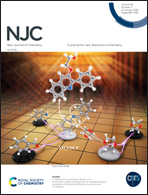A covalent modification strategy for di-alkyne tagged metal–organic frameworks to access efficient heterogeneous catalysts toward C–C bond formation†
Abstract
Organic and inorganic building blocks are used to construct a class of metal–organic frameworks (MOFs) that exhibit tremendous chemical tunability. In this study, a novel zirconium-based MOF UiO-66-(alkyne)2 with a di-alkyne tag was obtained through solvothermal pre-synthesis, which provides a potential covalent binding site for post-synthesis modification. On this basis, a gentle post-synthesis modification strategy based on covalency was expanded for introducing diverse metals, and a family of isostructural tailored materials (UiO-66-alkyne-Co, UiO-66-(alkyne-Co)2 and UiO-66-(alkyne-Ni)2) with base metals Ni or Co were designed and synthesized successfully. Among them, di-alkyne tagged UiO-66-(alkyne-Co)2 has shown unprecedented remarkable performance as a heterogeneous catalyst for the Knoevenagel reaction, completely converting benzaldehyde in just 5 min at room temperature, to our knowledge, faster than the reported MOF catalysts. Moreover, UiO-66-(alkyne-Co)2 maintains high stability and functionality after five cycles, and the catalytic activity is also preserved in the gram level scale-up experiment, indicating that UiO-66-(alkyne-Co)2 has great potential for practical application in the formation of C–C bonds. In a sense, this research provides an ideal platform for anchoring the required functional groups on alkyne-modified MOFs, which lays a foundation for finding more potential applications of MOF materials in the future.



 Please wait while we load your content...
Please wait while we load your content...